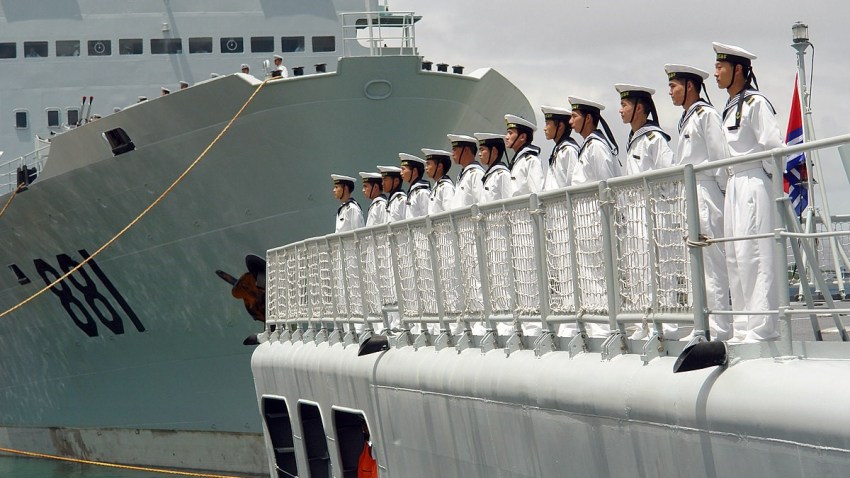In an increasingly crowded and contested western Pacific, navies from more than 20 countries—including the United States, China, Japan, India and Russia—want to make sure that incidents at sea don’t unintentionally escalate to broader conflict. This week, they agreed on a Code for Unplanned Encounters at Sea (CUES) at the 2014 Western Pacific Naval Symposium held in Beijing.
In a
statement, U.S. Chief of Naval Operations Adm. Jonathan Greenert, who attended the symposium, clarified that CUES “is not legally binding, but is an agreement upon which the participating nations have a standardized protocol of safety procedures, basic communications and basic maneuvering instructions to follow for naval ships and aircraft during unplanned encounters at sea.”
“We've agreed to establish common behavior at sea. We've agreed to prevent misunderstanding and miscalculations,” he added.
Mark Rosen, executive legal adviser at CNA Corporation, explains in a phone interview that even though such unplanned encounters do not happen very often, the intent of the code is for navies to train to common standards that will eventually become a “norm at sea.” This norm will hopefully apply to a broader range of encounters over time.
On a practical level, Rosen says, CUES will create “some expectation of bridge-to-bridge communication” between naval vessels. Commanders will “at least have an obligation to pick up the phone,” he says. This expectation would not only apply to encounters between U.S. and Chinese vessels, but also to interactions between the navies of countries like the Philippines, South Korea and Japan. The navies of all of these countries will likely continue to interact with Chinese patrols at sea as countries in the region assert their various territorial claims.
But the operational changes envisioned in CUES won’t happen immediately. It “will take some time for [CUES] to be implemented, except among navies that are already in friendly relations with one another,” explains Anthony Bergin of the Australia Strategic Policy Institute in an email.
CUES appears to be consistent with the overall U.S. goal of promoting a “rules-based order” in the Asia Pacific, a theme that Secretary of Defense Chuck Hagel has repeatedly emphasized, including during his recent visit to Beijing.
China has used similar rhetoric in describing its own approach to maritime issues. According to
China Military Online, a website run by the People’s Liberation Army, agreement on CUES “shows respect [for] generally accepted international rules and promotes the establishment of trust among navies of various countries in the region.”
The Wall Street Journal
reported this week, however, that it remains unclear whether China will actually abide by CUES. The newspaper quoted a senior Chinese navy official as saying that the actual implementation of the agreement would have to be discussed bilaterally with other nations.
Rosen says that concerns about Chinese noncompliance are premature at this point. The fact that CUES is not legally binding is “not an indication that the Chinese don’t intend to follow it. We’re going to have to wait and see,” he says.
Furthermore, China’s stated support of CUES comes after years of refusing to support such a code due to various concerns, including whether the code would be legally binding and what the code’s status would be within what China regards as its territorial waters. Given that details of the final agreement are not publicly known at this point, it’s not clear why the Chinese reconsidered their opposition.
Bergin speculates that the Chinese may be trying to show “that they want to contribute more to safety and good order at sea” in the context of the ongoing multinational search for a lost Malaysian airplane.
Even if CUES ultimately leads to more regularized naval interactions in the western Pacific, it does not resolve the more profound territorial disputes that worry U.S. allies and partners in the region. Furthermore, both China and the United States continue to invest in capabilities and doctrines that seem largely intended to challenge each other’s influence.
But incremental steps toward trust and consultation may produce positive effects over the longer term, Rosen says. “Over the long term, when these countries operate together from the same playbook it’s all positive.”
The U.S. experience during the Cold War gives some hope that agreements like CUES can continue to function even during periods of deep political tension. Rosen explains that CUES is loosely patterned on the U.S.-Soviet Incidents at Sea agreement finalized in the early 1970s. The agreement was finalized “at the height of the Cold War,” Rosen observes, and “despite terrible problems in our bilateral relations” consultations related to the agreement continued regularly. “Did it contribute to the peace?" he says. “It probably did.”
Photo: Chinese sailors man the rails aboard the destroyer Qingdao (U.S. Navy photo by Spc. Joe Kane).

